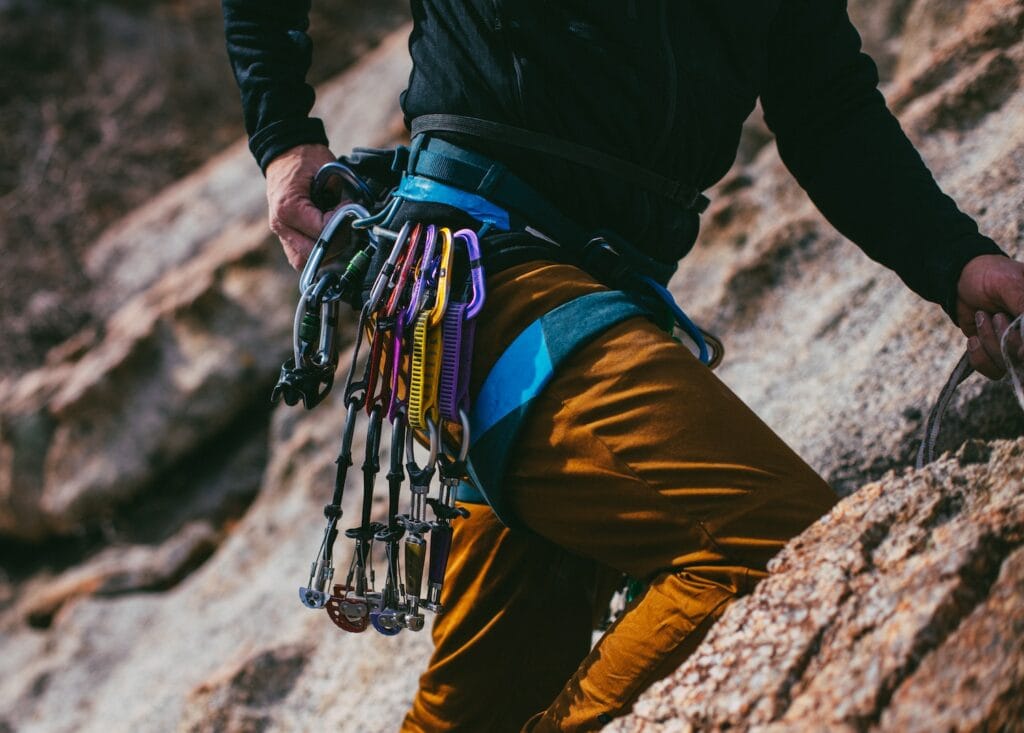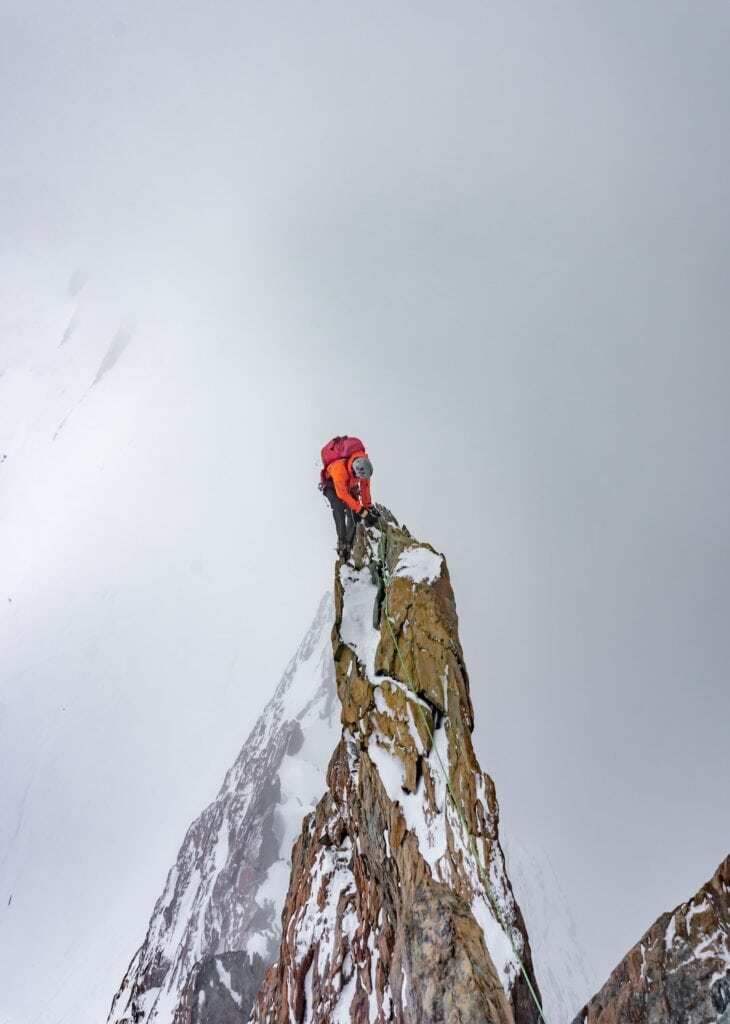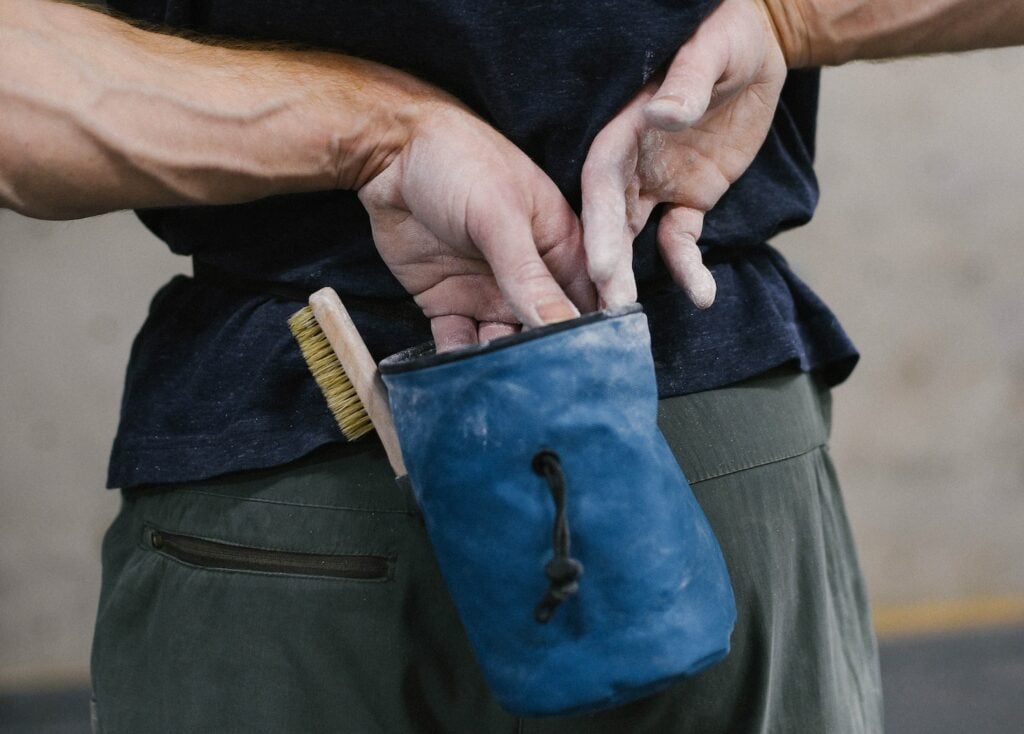What Is Free Climbing? The Definitive Guide (2023)

Published on: 05/08/2023
Introduction
Although the vast majority of rock climbers today practice free climbing, the term itself isn’t as commonly used as you might expect. In fact, many people have no idea what “free climbing” really is, confusing it with “free soloing” (which isn’t the same thing at all).
In this article, I’ll cover the types of free climbing, the differences between climbing free and free soloing, the history of the practice, and how you can get started, if you haven’t already!
What Is the Definition of Free Climbing?
Free climbing (as opposed to aid climbing) is any type of climbing that sees the climber ascending a formation entirely under their own power, using only the rock’s natural features and using gear only to protect in the event of a fall. That means no pulling on ropes or protection, no jugging fixed lines, and so on.
Free climbing is the opposite of aid climbing, which refers to ascending routes using artificial aid, such as ladders, hooks, and pitons.
Unfortunately, free climbing is a commonly mistaken term. Many people think that free climbing is the same as free soloing (a style of climbing where the climber ascends without any protection), but that’s wrong. Free soloing is a form of free climbing, but not all free climbing is free soloing. There are many other types of free climbing (e.g. sport climbing and bouldering) where climbers use protection as we will see in the next sections.

Is Free Climbing Dangerous?
All climbing involves some risk, but free climbing is not any more dangerous than any other climbing style. Indeed, the term “free” does not refer to the protection used. Free climbing can be incredibly safe (in the case of top roping) or incredibly dangerous (in the case of free soloing). It all depends on how the climb is protected.
What Are the Types of Free Climbing?
Top Rope
Top-roping, where the climber is protected by a rope fixed above the route, is technically a style of free climbing because the climber is attempting to ascend the route entirely under their own power. However, a top rope ascent is not usually considered a “free” ascent, because on top rope the belayer can inadvertently aid the climber.
Sport Climbing
This is the most common form of free climbing. Sport climbing routes are fixed with bolted protection, and the climber leads the route, placing quickdraws into these fixed bolts as they climb. If the climber pulls on the draws to ascend, then it is not considered a free ascent.
Trad Climbing
Trad climbing is another common form of free climbing, eschewing fixed bolts as protection, instead using removable traditional gear, such as cams, nuts, hexes, and tricams.

Bouldering
When bouldering, a climber ascends a shorter route (usually 10 to 15 feet) with a pad placed below for protection in case of a fall. Bouldering is always free climbing, as there is no way to aid an ascent.
Ice, Mixed, and Alpine
Many ice, mixed, and alpine routes are climbed free as well, but occasionally climbers will opt to aid short portions of a route if they cannot be well-protected or the difficulty is too high. Again, if the climber does not use any artificial gear to make upward progress, then the route is climbed free.
Note: The use of ice axes and crampons is not considered aid.

Free Soloing
Free solo climbing, ascending a route without any protective gear whatsoever, is also free climbing. It is by far the most dangerous form of climbing. A fall will likely result in serious injury, if not death.
What Is the Most Difficult Type of Free Climbing?
No style of free climbing is inherently more difficult than any other, although out of the styles listed above, most would consider ice, mixed, and alpine climbing the most physically and technically demanding. A free solo climb, however, does require much more mental strength than any other discipline.
What’s the Difference Between Free Climbing and Free Soloing?
Commonalities
Both free climbing and free soloing eschew any aid techniques to assist a climber’s upward progress. Free climbers and free soloists ascend routes entirely with their own arms and legs.
Differences
The difference between free climbing and free solo climbing is that free soloing means eschewing all protection. Free soloists do not use ropes, harnesses, or gear to secure themselves to the wall and arrest a fall.
Note: Not all solo climbing is free solo. There are some soloists who free routes while using protection (rope soloing), and aid soloists as well.
Risk
Free climbing can certainly be dangerous, depending on the style of climbing, the climber’s experience level, rock and weather conditions, and many other factors. But free solo climbing is infinitely more dangerous. Aside from rock shoes and chalk, a free soloist has no equipment whatsoever, and no protective gear to arrest a fall. Unless you fall at the bottom of the route, any fall while free soloing results in injury, and often death.

Popularity
Free soloing is well known in the mainstream because of the popularization of figures like Alex Honnold and successful climbing films like The Alpinist and Free Solo. However, a very, very small percentage of climbers free solo, and few make a habit of it (for obvious reasons).
How Did Free Rock Climbing Start?
Origins
Free climbing began in the early 20th century after Austrian climber Paul Preuss advocated for the style’s distinction from aid climbing (coining the term “artificial aid”) in the German Alpine Journal in 1911. Among other principles, Preuss held that “the piton is an emergency aid and not the basis of a system of mountaineering,” beginning the original free climbing vs. aid climbing debate.
Free climbing was popularized during climbing’s boom in the latter half of the century. Climbers then transitioned away from “any means necessary” ascents and towards clean climbing (removable pro) ethics under the tutelage of figures like Yosemite Valley’s Royal Robbins. Free climbing was a natural “next step” after clean climbing, and in the last three decades of the 1900s, it quickly the default style of rock climbing.

Who Are the Pioneers of Free Climbing?
German Frankenjura climber Kurt Albert was perhaps the first early pioneer of free climbing as we know it today. Albert would pain a red dot (Rotpunkt) at the base of any climb he managed to free. This is where the modern term “redpoint” (ascending a route free, in one continuous push, for the first time) comes from.
Albert was also responsible for outlining the ethics of a free sport ascent, including the concept that a climber must ascend the route from bottom to top without any falls (if you fall, you must lower, pull the rope, and begin anew).
Other pioneers of free climbing include German Wolfgang Güllich, the first climber to redpoint 5.13d, 5.14a, 5.14b, and 5.14d, John Gill, the American godfather of bouldering, who popularized the discipline and many relevant training regimes, and Catherine Destieville, a French sport climber and alpinist who was the first woman to redpoint 5.13a/b and 5.13c.

There’s also Lynn Hill who made the first free ascent of The Nose (VI 5.14a C2 3,000′) on El Capitan in 1993. She’s perhaps the most famous free climbing pioneer in the United States, and also an early figurehead in the women’s climbing movement. Hill was the first woman to redpoint grades 5.12b to 5.13a, as well as 5.14a, and the first to onsight 5.13b. Her 2002 autobiography Climbing Free: My Life in the Vertical World, is an excellent account of these and her other accomplishments in the sport.
What Are the Most Notable Free Ascents?
As grades have continued to increase, notable free ascents have as well. Some of the most notable, however, include Hill’s free ascent of The Nose, Güllich’s Punks in the Gym the first consensus 5.14a, and Hill’s Masse Critique, the first female ascent of the same grade.
Other sport climbing classics include Chris Sharma’s 2001 send of Realization, the first consensus 5.15a, and La Rambla (5.15a) the first female ascent of the grade by Margo Hayes in 2017. In recent years, of course, Adam Ondra and Sébastien Bouin have pushed the 15 grade up into the 5.15d range, both proposing the grade for their (unrepeated) Silence and DNA, respectively.

Taking big walls into account, it’s also worth mentioning the Dawn Wall, a 32-pitch 5.14d on El Capitan free climbed by Tommy Caldwell and Kevin Jorgeson in 19 days, after seven years of developing and projecting. The above list, focusing primarily on sport, is in addition to the slew of hard boulder problems and trad climbing ascents.
How Do You Get Started With Free Climbing?
Can Anyone Do Free Climbing?
Anyone can become a free climber. Free climbing is the most common form of rock climbing and is much easier to learn than aid climbing, which incorporates significantly more gear and technique.
What’s the Most Important Skill for Free Climbing?
The knowledge to keep yourself and your partner(s) safe is the most important skill in any climbing situation. However, the most important skill for freeing a route, in general, is physical fitness. Free climbing is about ascending routes using only your own body and nothing else. Aid climbing, on the other hand, is about ascending routes using any means necessary (while complying with fair ethics).
What Gear Do You Need for Free Climbing?
The gear you need for free climbing depends on the style of free climbing you’re performing (see above). For bouldering, all you need is climbing shoes and a crash pad (and possibly chalk). If you practice sport climbing, you’ll also need a rope, harness, helmet, and quickdraws, at least. For traditional climbing, you’ll also need removable pro and anchor-building gear, like cams, nuts, and slings.

What Are the Rules of Free Climbing?
When free climbing, a climber can only use the natural features of the rock and their own body to ascend the rock formation.
You cannot pull or stand on any artificial feature, like a bolt or piton, and you can only place gear in the wall to protect against a fall. Other rules apply depending on the class of ascent (such as redpoint, flash, and onsight), but this is the general rule of free climbing.
Is Hangdogging Allowed?
“Hangdogging,” which refers to incessantly hanging on the rope to rest while climbing a route, disqualifies a free ascent. To fully “free” a route, the climber must ascend the route from bottom to top without any falls. However, in many cases, hangdogging is a common way to work a project and prepare for an upcoming redpoint attempt
Where Can You Free Climb?

Outside
You can free climb at any outdoor rock climbing destination, from a boulderfield to a sport crag to a trad climbing destination. Just be sure you have the skills to protect the climb and do your research regarding access beforehand.
Gyms
You can free climb in any rock climbing gym in the world. Bouldering, top roping, and sport climbing are all styles of free climbing, and all can be practiced in the climbing gym.
Buildings
Some climbers, like Frenchman Alain Robert, make a practice of free climbing buildings and other artificial structures. This is almost always illegal. If you intend to free climb a building, secure proper permission from the owner (or don’t get caught…).
